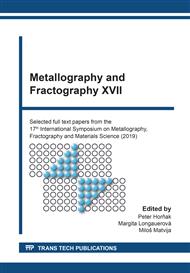[1]
J. Lachowski, J. Borowiecka-Jamrozek, Modelling Thermomechanical Response of a Diamond Particle in a Metallic Matrix, Engineering Transactions 65, 1 (2017) 105-112.
Google Scholar
[2]
J. Borowiecka-Jamrozeka, J. Lachowski, Modelling of retention of a diamond particle in matrices based on Fe and Cu, Procedia Engineering 177 (2017) 289-296.
DOI: 10.1016/j.proeng.2017.02.227
Google Scholar
[3]
SIMULIA Dassault System, Abaqus/Explicit, ver. (2017).
Google Scholar
[4]
D.A. Akyuz, Interface and microstructure in cobalt-based diamond tools containing chromium, PhD thesis, Ecole Polytechnique Federale de Lausanne, Lausanne, (1999).
Google Scholar
[5]
J. Borowiecka-Jamrozek, Engineering Structure and Properties of Materials Used as a Matrix in Diamond Impregnated Tools, Archives of Metallurgy and Materials 58, 1 (2013) 5-8.
DOI: 10.2478/v10172-012-0142-0
Google Scholar
[6]
V.A. Mechnik, Production of diamond-(Fe-Cu-Ni-Sn) composites with high wear resistance, Powder Metallurgy and Metal Ceramics 52, 9-10 (2014) 577-587.
DOI: 10.1007/s11106-014-9563-9
Google Scholar
[7]
J. Konstanty, D. Tyrała, A. Radziszewska. Iron-base materials manufactured from premixed powders by the hot press process. Archives of Metallurgy and Materials 54, 4 (2009) 1051-1058.
Google Scholar
[8]
Xiaojun Zhao and Longchen Duan, A Review of the Diamond Retention Capacity of Metal Bond Matrices, Metals 8 (2018) 307;.
DOI: 10.3390/met8050307
Google Scholar
[9]
T. Mura, Micromechanics of defects in solids, Martinus Nijhoff Publishers, The Hague, The Netherlands, 74-75, (1982).
Google Scholar
[10]
R.R. Reeber, K. Wang, Thermal expansion, molar volume and specific heat of diamond from 0 to 3000K, Journal of Electronic Materials 25 (1996) 64-66.
DOI: 10.1007/bf02666175
Google Scholar
[11]
Xiuyu Chen, Guoqin Huang, Yuanqiang Tan, Hui Huang, Hua Guo and Xipeng Xu, Model Establishment of a Co-Based Metal Matrix with Additives of WC and Ni by Discrete Element Method, Materials 11 (2018) 2319;.
DOI: 10.3390/ma11112319
Google Scholar


